The beach between Sainte-Honorine and Vierville-sur-Mer is one of the most renowned beaches in the world. Not for its white sandy beach, surf, waves, and picturesque surroundings. No, this beach was the scene of the American invasion during D-Day. The codename for this operation was Omaha Beach. Therefore, this is a beach that you should definitely visit when in Normandy. Because on June 6, 1944, the liberation of Western Europe began here. The following significant places full of history and emotion should not be missed at Omaha Beach.
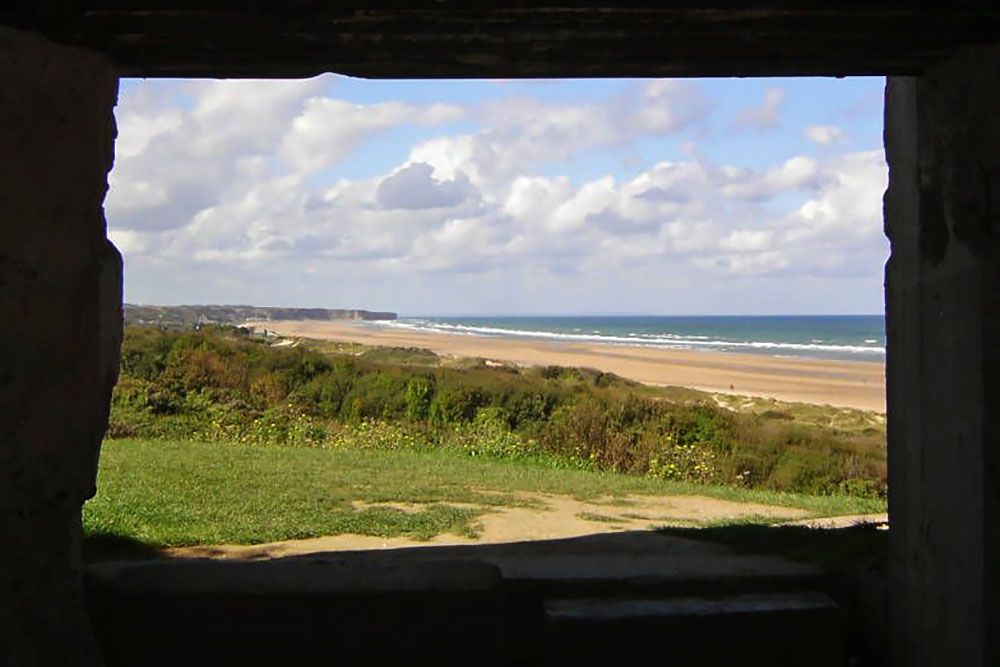
Omaha Beach and D-Day
Omaha Beach was one of the five landing beaches during D-Day on June 6, 1944. The objective of the landing on Omaha Beach was to establish a foothold in Normandy. The area between Port-en-Bessin and the Vire River had to be conquered as quickly as possible. Then, an advance towards Saint-Lô was possible. This city was strategically important because it was a crucial transportation hub. Conquering Saint-Lô meant that the road to the inland was open.
The operation on Omaha Beach was challenging. The German defense was stronger than expected, and the American soldiers came under heavy fire. The first wave of attack ended in a massacre and yielded no success. During the second landing, troops faced many casualties in the surf and on the beach. Much of the American equipment had been completely destroyed in the first attack, hindering the troops’ progress in the sea and on the beach. The Nazis relentlessly fired their ammunition from the bunkers at the troops.
It seemed that the operation was doomed to fail. Yet, the soldiers managed to climb the steep slopes at the end of the beach. After a few hours, they were able to attack the Germans. In the battle, the Americans then gained the advantage. However, the cost was high: more than 2,000 American soldiers fell on the first day of the Battle of Normandy. Despite the heavy losses, the troops ultimately managed to break the German defense and establish a foothold.
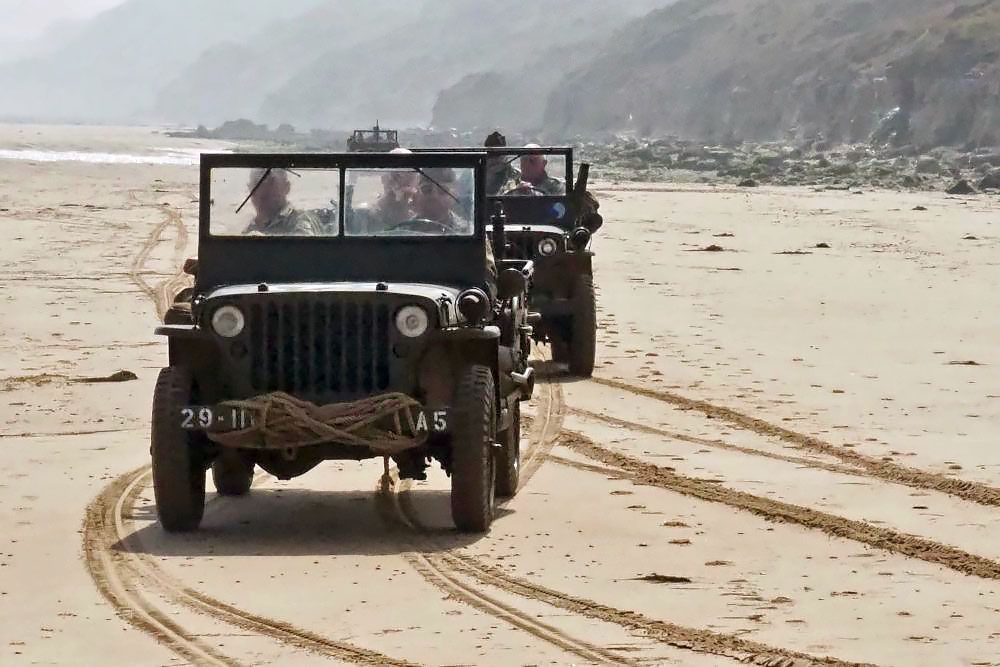
D-Day sites at Omaha Beach
The D-Day sites at Omaha Beach are all impressive, each with its own significance.
Monument on the beach
At Omaha Beach, the monumental tribute to the American soldiers who landed on 6th June 1944 cannot be missed. Named “The Braves,” this monument, crafted by French sculptor Raymond Mason, was unveiled in 1956.
Comprising three parts:
- “The Call of Hope”: A bronze statue of a soldier reaching out to the sea, symbolizing the soldiers’ hope for a better future.
- “Rise, Freedom!”: A bronze statue representing a soldier preparing to fight, symbolizing the courage and determination of the soldiers.
- “The Wings of Fraternity”: Two bronze wings symbolizing the soldiers who flew over the ocean to liberate Europe.
The monument also bears the names of the American soldiers who perished at Omaha Beach, serving as a poignant memorial and a symbol of the freedom fought for by the American soldiers for Europe.
We visited the monument a few days after 6th June, finding the flowers and wreaths still fresh, and the site bustling with visitors, including many Americans and interested individuals from various countries, taking a moment for reflection.
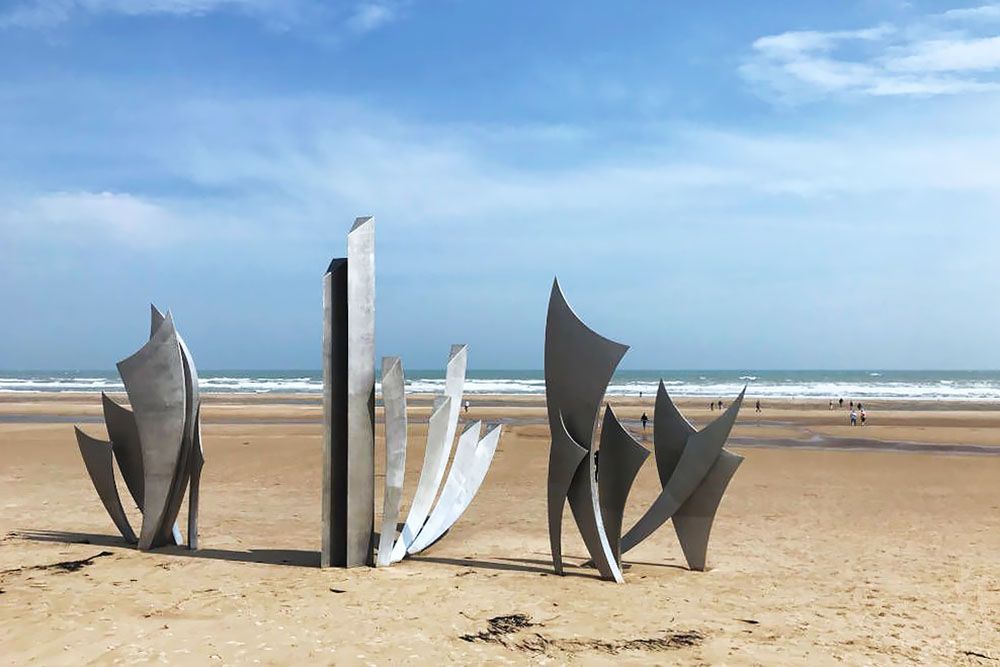
American Cemetery
In fine weather, we visited the American Cemetery. The sun shone, casting a shimmering light on the numerous trees surrounding the cemetery. Birds sang in the trees, creating a peaceful atmosphere. Seeing the beautiful surroundings, it was hard to imagine the tragedies that unfolded here.
However, the reality is that nearly 10,000 young American men found their final resting place here. The neatly arranged white crosses stand as a sobering testament to their sacrifice for our freedom. Walking among the almost countless graves, we were deeply moved. There are over 300 anonymous graves, with the inscription “Known but to God” on the white crosses. It was striking to see many high school students visiting the cemetery, coming from various countries. They experienced firsthand the price of peace and the need to cherish it, especially in times of international tensions. They moved around the vast grounds in rapt attention. We also encountered many American families, visiting the graves of their loved ones who fought far from home for our freedom.
The visitor center provided extensive information about the cemetery, the D-Day landings, and the Second World War, showcasing maps, photographs, videos, and personal stories of soldiers. Of course, we also visited the central memorial, a chapel with a bronze statue of Mary, and nearby, a large seven-meter bronze statue of a young man with his arms raised, symbolizing a new and hopeful beginning for American youth.
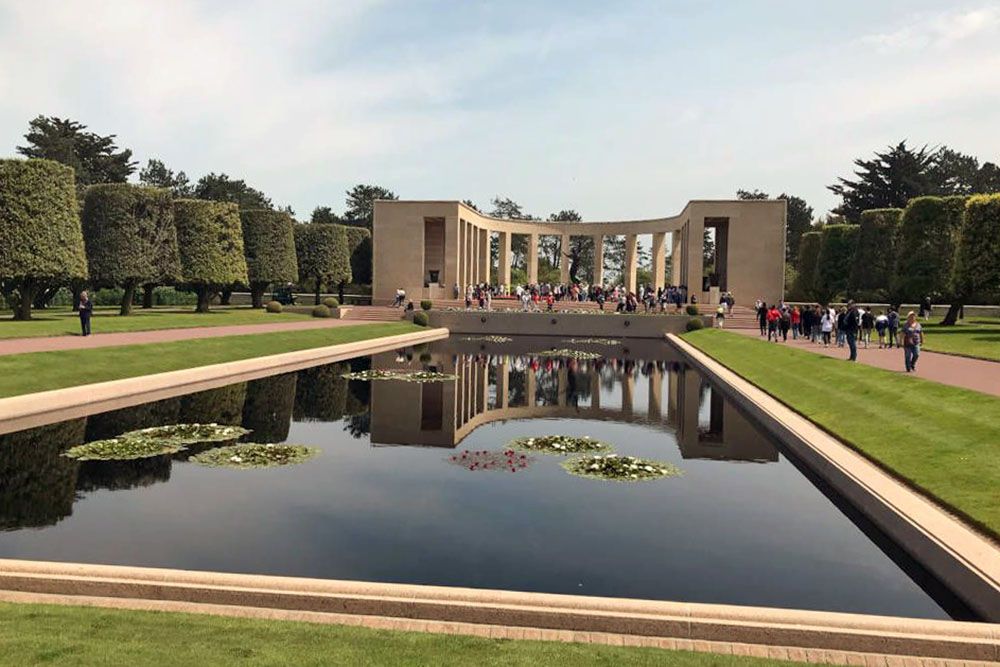
Pointe du Hoc
Pointe du Hoc, a significant 30-meter-high cliff, holds special importance. German bunkers at Pointe du Hoc had the capability to target both Utah Beach and Omaha Beach with their cannons. It was crucial to neutralize this threat. The operation required immense courage and determination, especially as the large bombardments before D-Day seemed to have been unsuccessful.
On D-Day, 225 American Rangers, led by Colonel James Rudder, landed at Pointe du Hoc. They scaled the cliff in a daring assault. The attack was fierce, with 76 Rangers killed and 90 wounded out of the 225. The Germans lost approximately 120 men. Eventually, the Rangers reached the bunkers containing the cannons. They made a surprising discovery: the Nazis had removed the cannons and replaced them with wooden beams. The Americans later found and destroyed the actual location of the cannons, thereby averting deadly artillery fire on Utah Beach and Omaha Beach.
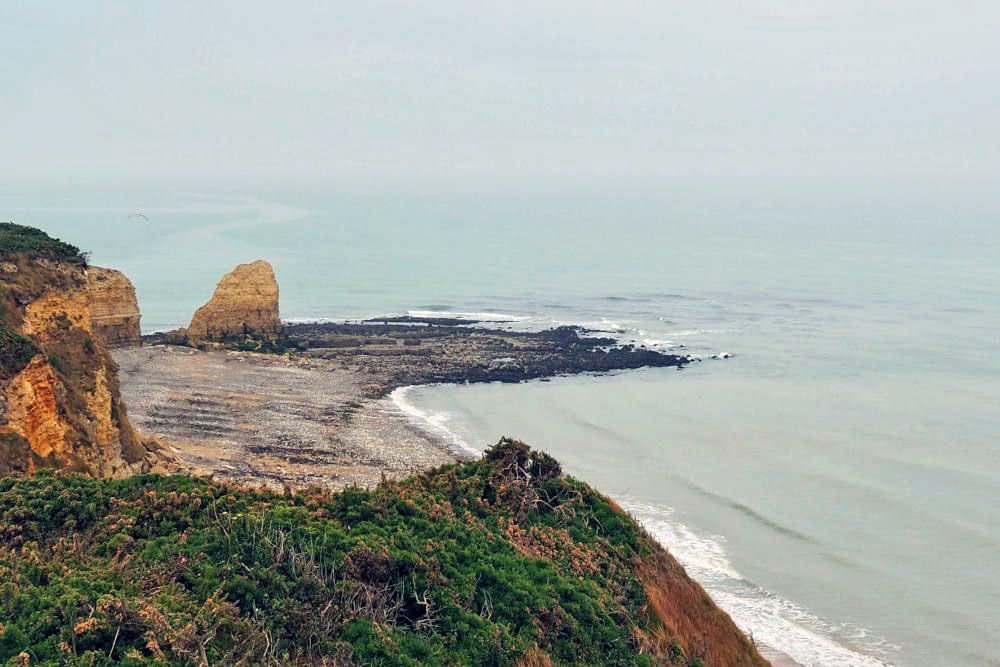
Marrow and bone
The small museum showcased films featuring survivors recounting their harrowing experiences during the Pointe du Hoc assault, leaving a profound impression on us. The courage shown under such dreadful circumstances was truly remarkable. Some of the survivors’ testimonies, engraved on the museum walls, will stay with us for a long time.
We then walked through a landscape reminiscent of the moon, towards various significant locations. Everywhere, there were bomb craters from the pre-attack bombings. We entered the undamaged bunkers, with the bunker near the cliff particularly memorable. We imagined how the Germans shot at the Rangers from this position during their courageous ascent. The tall needle-shaped memorial towered above the observation post. Lost in thought, we spent at least an hour traversing the site, reflecting on the events that unfolded at Pointe du Hoc.
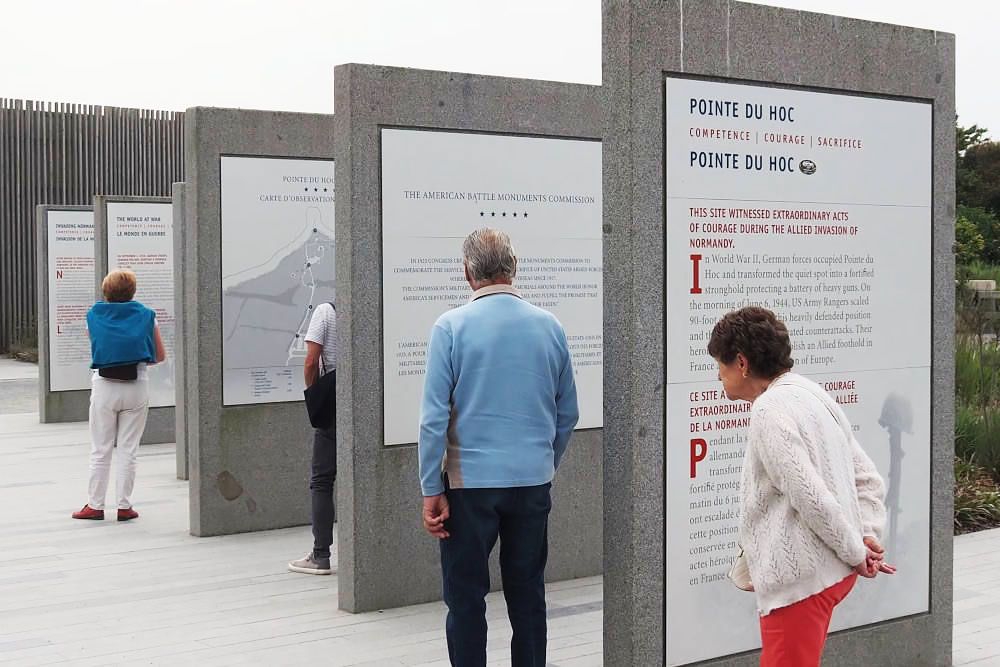
Fatbiking on Omaha Beach
Though it may seem unusual at first to embark on an enjoyable bike ride on Omaha Beach, it is a serious undertaking. Our guide Laurent is a walking encyclopedia when it comes to the June 6 invasion. Every time we pause, he narrates an exciting true story about the attack. Thus, we gain a wealth of knowledge from him during the bike ride.
On our electrically powered fatbike, we glide from one interesting spot to another. Everywhere, Laurent, tirelessly as ever, shares an intriguing tale. Naturally, we make a stop at the monument on the beach. There, we walk uphill along a path leading to a bunker. In the bunker, our guide produces a tablet and speaker. We watch a film about the invasion on Omaha Beach. Images speak louder than words, so we watch in silence, deeply impressed by the footage.
As we cycle back, we encounter a few jeeps on the beach. Volunteers who participated in the D-Day commemoration in recent days wave at us. During lunch, Laurent continues with his stories tirelessly. We almost run out of time to reach the next D-Day memorial site. This, too, has become an unforgettable experience. In addition to the relaxing bike ride along the beach, we have heard captivating stories. It is highly recommended to take this tour. More information about fatbiking on Omaha Beach.
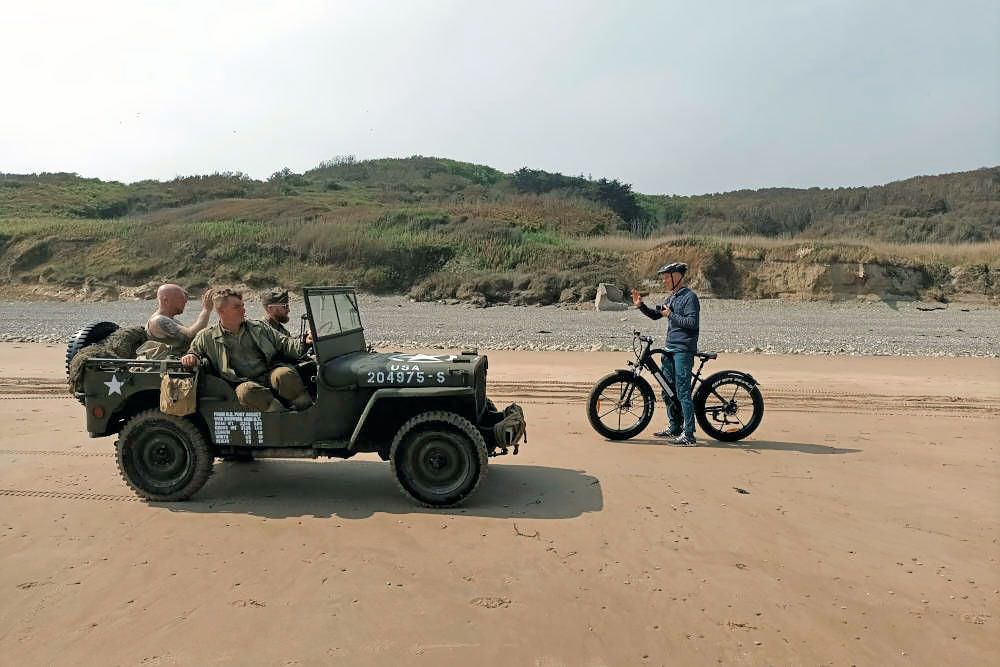
German Military Cemetery
Not only did many allies lose their lives during D-Day and the subsequent weeks, but many German soldiers also perished in the sometimes bloody battles. They did not choose this battle themselves and became victims of the madness of their Nazi leaders.
This cemetery attracts fewer visitors than the American one a few kilometers away. Nevertheless, it is a special place deserving more attention. We were particularly struck by its simplicity. Many graves are identifiable only by a flat stone in the grass. Occasionally, there are groups of reddish-brown basalt crosses with no names of the deceased. In total, over 21,000 German soldiers lie here, sacrificed for a senseless struggle and dying young during the battles in early June 1944. The narrow entrance is also remarkable. Only one person can enter the cemetery at a time. The architect deliberately designed it this way to ensure automatic peace and quiet upon entering the graveyard.
In the middle of the cemetery stands a large hill with a dark basalt lava cross. Two statues stand on either side of the cross. This is the final resting place for over 200 unknown German soldiers, interred in a mass grave. At the entrance of the cemetery, we visit the small visitor centre. Despite having seen and heard a lot about D-Day in Normandy, it is remarkable that every museum or visitor centre chooses a unique perspective.
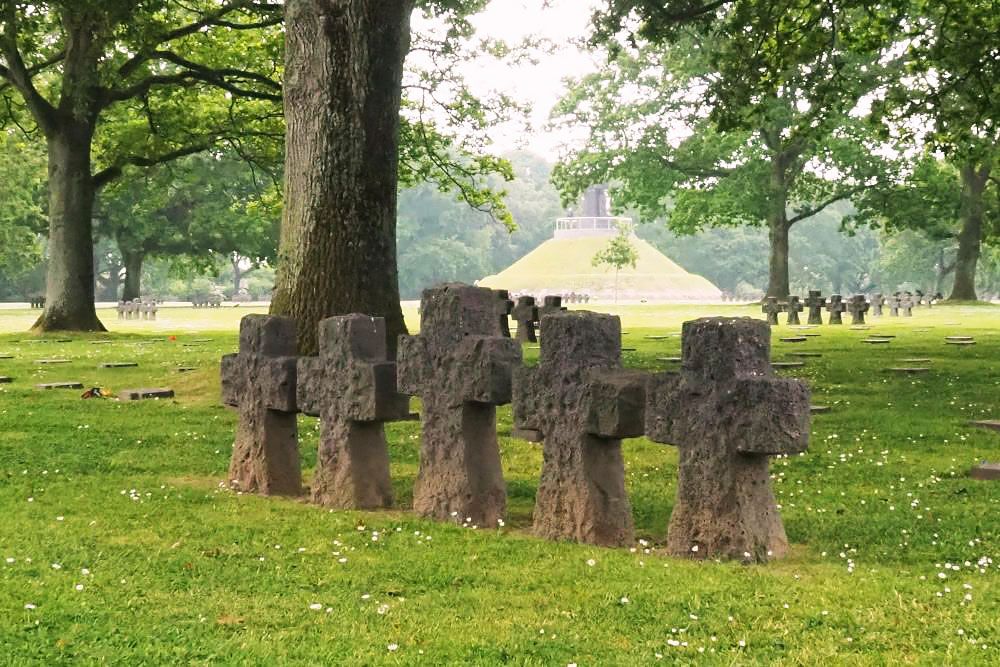
Other interesting locations near Omaha Beach
There are other attractions worth visiting around Omaha Beach:
- Overlord Museum Omaha Beach: An interesting museum located 500 meters from the American cemetery, featuring a collection of 10,000 items including cars, tanks, cannons, and many interactive presentations.
- Omaha Beach Memorial Museum: This museum at the Omaha Beach shore includes a large collection of uniforms, personal items, weapons, and vehicles. Numerous reconstructions of American and German scenes immerse you in the heart of the history of the D-Day landings and the daily lives of the men and women who came for our freedom.
- Maisy Battery: This German bunker complex was intended to protect the Utah and Omaha Beaches from an attack. On June 9, 1944, American rangers captured the positions after fierce fighting. After more than 60 years hidden underground, the Maisy Battery is now open to the public. You can walk through original German trenches and explore the bunkers.
With these illustrious sites, you gain a more than complete picture of the events during D-Day on and around Omaha Beach. If you want to take a break from all the wartime violence and see or do other things, then look at our page about Normandy. There, you will undoubtedly find inspiration.
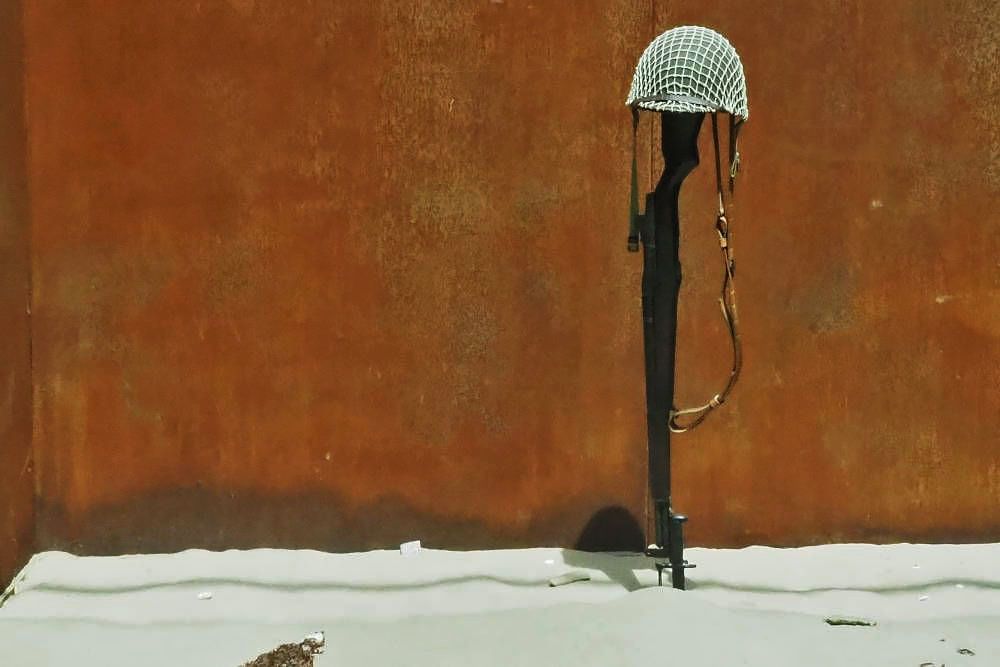
Practical information for visiting D-Day sites at Omaha Beach
Omaha Beach is located near the Normandy town of Bayeux and extends along the coast of the French municipalities Sainte-Honorine-des-Pertes and Vierville-sur-Mer.
Omaha Beach played a crucial role during D-Day as one of the five Allied landing sites on June 6, 1944, assigned to the American troops. Conquering Omaha Beach was essential for establishing a firm foothold for the Allies in Normandy. However, the American troops faced heavy German defenses, leading to one of the bloodiest and most challenging battles of D-Day. Ultimately, the Allies successfully captured Omaha Beach, marking a turning point in the fight against Nazi Germany in Western Europe.
The D-Day commemorative sites at Omaha Beach include various impressive locations:
- Landing Monument on the beach, a tribute to the American soldiers who landed on Omaha Beach on June 6, 1944. It is a creation of the French sculptor Raymond Mason and was inaugurated in 1956.
- The American cemetery, where nearly 10,000 American soldiers who sacrificed their lives for freedom have found their final resting place. The white crosses serve as a poignant tribute to their sacrifice.
- Pointe du Hoc: This cliff and its associated museum commemorate the courageous battle to neutralize the German bunkers. Survivors share their poignant stories, providing visitors with a deeper insight into the hardships of the attack.
- The German military cemetery, which houses over 21,000 German soldiers who lost their lives in the battle. The serene setting invites contemplation.
In addition to these commemorative sites, there are other interesting locations in the area, such as the Overlord Museum Omaha Beach, the Omaha Beach Memorial Museum, and the Maisy Battery. Each offers a unique perspective on the history of the D-Day landings.
The D-Day memorials and other interesting locations around Omaha Beach are fairly spread out. Therefore, a (rental) car is the most obvious transportation option. Alternatively, an excellent option is the bus from Bayeux, the nearest major city. Additionally, various tours are available through our partner GetYourGuide. Aside from tours by minibus, tours are also possible by e-bike or even by motorbike with a sidecar! However, keep in mind that such tours involve relatively short visits to the various commemorative sites, making them less suitable for those with a keen interest in history.
There are several accommodation options available in the vicinity of Omaha Beach, ranging from hotels to holiday homes. Here are some recommended options.
Hotels near Omaha Beach:
- La Sapinière: Hotel in Saint-Laurent-sur-Mer with a convenient location just a few minutes' walk from Omaha Beach. Guests appreciate the comfortable rooms, the terrace, and the nearby beach. This hotel offers a practical and clean stay with free parking.
- Villa Omaha: Hotel in Saint-Laurent-sur-Mer with a good location for visiting Omaha Beach. Guests appreciate the proximity to the attractions and the beach.
- Gite La Hulotte: Accommodation in Saint-Laurent-sur-Mer with a terrace, free WiFi, and garden views.
- Les chambres d'Omaha Beach: Establishment with two guest rooms, including homemade breakfast and local products, located in Vierville-sur-Mer, 2 km from Omaha Beach.
An alternative is staying in the charming medieval town of Bayeux, which also serves as the perfect base for most invasion beaches. View accommodations in Bayeux.
Other topics you may be interested in
- D-Day memorial sites: Journey to the birthplace of peace
- On a cycling holiday along the Vélomaritime in Normandy
- Normandy: historical sights and beautiful nature
- Mont-Saint-Michel, iconic island near Normandy
- Côte d’Albâtre in Normandy | the nicest villages



